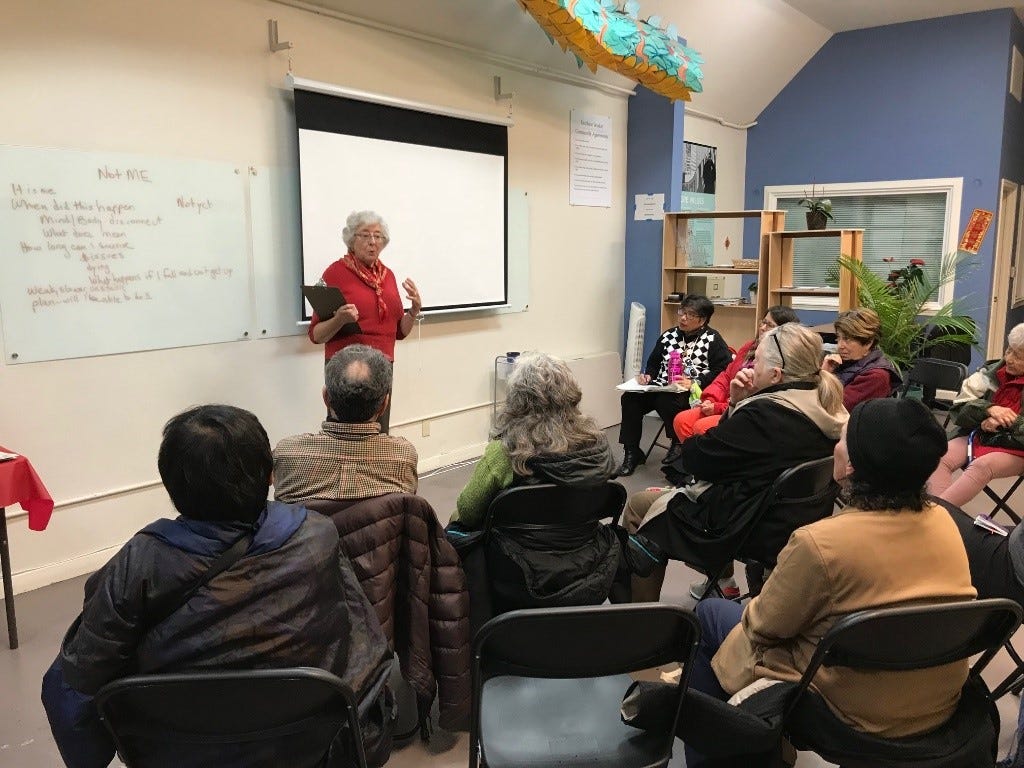
How do I retire without retiring?
I puzzled over this question for months and months.I knew it was time for me to do something else, but how to describe my internal process? At first, I wasn’t sure if I was comfortable with the term “retirement” and all its implications.
I certainly didn’t want people to think that I had simply quit, walked away from a long and successful retail career... Would they imagine that I had been unhappy with my job? Would they think that I believed leisure was better than what I’d been doing? Neither one is true. So, how could I explain my decision to retire and what it meant to me?
The irony for me was—I wasn’t even choosing leisure at all. In reality, I’d been drawn into a group called At Home With Growing Older.
One day, by chance, I bumped into the Executive Director at the Oakland Museum of California and we soon discovered that not only are we both architects, but we also both focus on age-friendly design. Susi told me about her nonprofit, At Home With Growing Older and, soon enough, I was attending their At Home, On Air programs and taking the Aging 360™ course. The course offered me a chance to look at my kitchen and imagine how I could adapt my home to better serve me as I age. It opened my eyes to a whole new way living in my home, one that took delight as well as safety into account. I actually ended up taking the workshop twice.
As I moved closer and closer to retirement, I knew this organization was the right place for me to contribute my time and experience. My former employer sent out an email telling my colleagues what I would be doing. That gave me a great opportunity to talk about what it means to be at home with growing older—which was exactly what I was learning how to do myself with the help of Susi and others.
I’ve appreciated all the conversations I’ve had with former colleagues who asked me to tell them all about my encore career, and I’ve told lots of other people about it, too. Now I don’t care if we call it work or retirement or volunteering. When I talk about it, people smile, sometimes with curiosity and sometimes with envy. They’ll find themselves here eventually, in retirement and maybe they’ll even ask my question: How do I retire without retiring?
I found my way, and now, I’m at home with growing older.
Three months into my new life of 'retirement', my home is my comfort. When the impact of COVID forced us to work from home, we had to rethink how we use our spaces. I settled into the living room in the front of the house, and my husband took the spare room in the back of the house. I enrolled for a second time in the Aging 360™ course to make adjustments to our bathroom. I didn't realize it at the time, but the course work prepared me to think about how to adapt my work-from-home office space, our living room, to support my new 'encore' career at home as well. I could see how patterns of use develop over time, and by rearranging furniture, I can get a new vantage point and reallocate space for new activities.
The living room is my favorite room in the house, with a vaulted ceiling, columns, arched windows and wood floors. I found myself wanting to transition my 'work' table into my 'creative' table. Gone are the files, the in/out baskets, and spiral tablets of meeting notes. I organized my art supplies and drafting supplies on a nearby shelf. I brought out my sewing machine to prompt new creative endeavors. I changed curtain panels, hoping to create some privacy from the street with opaque, raw silk panels and I even eliminated some unnecessary furniture.
I also hung a large framed portrait drawing of a lion I did in art class over 50 years ago. My California state architectural license hangs here too. These remind me of accomplishments in my past to inspire me to go after new opportunities. Nearby, I have my reading and meditation seat, where I find calmness through meditation and inspiration in the books that I’m currently studying. I surround myself with a few items, leaving lots of blank and open space. When I close off the room with double doors, it enhances my sense of personal space with comfort and privacy.
I’m even considering painting the walls, but I won’t let the painting project distract me from exploring my passions - brainstorming At Home With Growing Older programs, improving the Aging 360™ course, writing stories and enjoying my interest in design and other creative pursuits.
AGE FRIENDLY DESIGN FOR YOUR HOME
Standards/Facts:
Typically an age-friendly or age-ready home is considered to be all about safety and accessibility. According to the official definition an age-ready home is a home with a step-free entry, a bathroom on the 1st floor and at least one safety feature, such as a safety bar in the bathroom. Only 1% of homes in the US are age-friendly.
Most people shy away from making even simple adaptations because they are afraid of admitting that they need accommodations. Many people don’t have the resources to adapt their homes.
I believe in choice :
We can take initiative: Very few of us will ever live in a 100% age-friendly home, but we can do things that will improve our home and make it safer, more comfortable and more delightful as we get older and our abilities change.
Tips:
Reorganize kitchen cabinets so that items of daily use can be easily reached.
Attach battery LED lights to the underside of your upper kitchen cabinets to make food prep easier.
Keep your windows clean and make sure they can open easily.
Consider your favorite piece of furniture, making sure that it is in an easily accessible and comfortable location. For example, move your favorite chair so that it gets more natural light for reading or a makes it easier to look out the window
Add a firm seating pillow on chairs that you use a lot, making it easier to get up and sit down. Even if the change in height is only one inch one, it will make a difference.
Add some height to your toilet if it seems too strenuous to use. You can get a handyman to install a pedestal under your toilet (a so-called toilevator) or you can simply add a toilet seat riser ( i.e. a higher toilet seat on top of your toilet). Some are prettier than others….
You can also install a bar with suction cups to get in and out of the bathtub or shower. While you can’t put weight on it, it is only 12-inches long and can really help with balance.
Some other thoughts:
Making a space your own is part of making a home age-friendly. For Howard it meant converting a living room into a creative studio space. For you it might mean putting your energy into decluttering your dining room so that you feel good about inviting people over and nourishing your community with good food. For others it might be having a weekly budget for flowers, allowing them to bring nature into the home.







